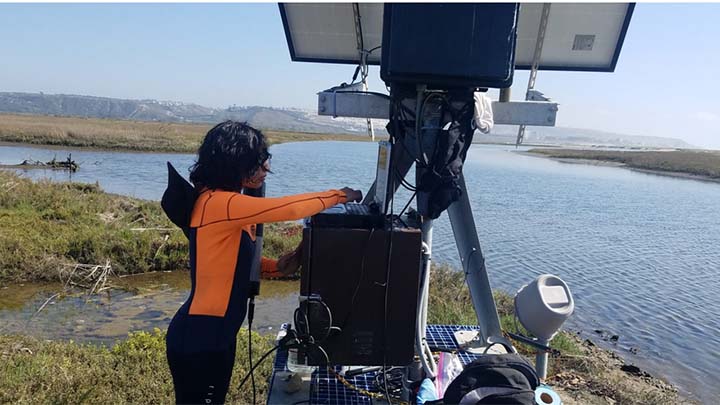SDSU Study Demonstrates Viability of Smartphone Alerts for Water Quality Monitoring
Sensors deployed in the Tijuana River Estuary, which is contaminated by untreated wastewater spilling out from Mexico, effectively detected both the presence and concentration of harmful compounds in the wetland that empties into the ocean near Imperial Beach.
Natalie Mladenov, a professor of environmental engineering in the College of Engineering and director of the Water Innovation and Reuse Lab (WIRLab), said the sensor platform demonstrated the ability to provide “an early warning” along the coast near the border, and potentially in other places impacted by wastewater worldwide.
Mladenov and Trent Biggs, a professor of geography in the College of Arts and Letters, began deploying the sensors about two and a half years ago. At the time, the prospect of collecting real-time data of what was then intermittent sewage flows promised to be particularly useful for Imperial Beach swimmers and surfers, Navy SEALs doing exercises off the coast of Coronado, and others along the southern coast who need to know of public health risks without waiting up to two weeks for samples to be analyzed.
Then the contamination became “a constant, daily occurrence, nonstop,” Mladenov said, with 40 to 60 million gallons of wastewater flowing daily making the technology less useful Lately, however, the contamination has eased, and in fact the sensors have confirmed the improvement in water quality.
More importantly, though, the sensors proved to work, successfully capturing a fluorescent signature in sewage and transmitting data back to WIRLab where it then can be viewed on a website. Their findings also revealed how tidal action affects the level of contamination in the estuary.
The fieldwork, which was assisted by SDSU students, also showed the sensors need regular maintenance. Biggs said “biofouling, where you’ve got little critters growing” on the sensors, “happens almost instantly when you put it in seawater.”
“We get algal growth, we found little tiny mollusks growing on things,” he said. “We have a wiper system that’s supposed to take care of that, but it doesn’t always work. So you end up having to go in the water to really get (the equipment) a real clean down every couple weeks.” That’s a problem if the water is too dirty for physical contact.
The instruments also lose sensitivity over time, resulting in inaccurate measurements. Sediments stirred up by turbidity can confuse the sensors, and the technology probably may not be suitable for an open ocean.
That still leaves plenty of value for the sensors in the estuary. Mladenov noted the eventual completion of improvements to the International Boundary and Water Commission’s border treatment plant, along with work in Tijuana to improve currently overrun collectors, could make sewage spills less chronic and real-time data more vital.
Encased within a submerged platform, the sensors emit a light beam that strikes water molecules. Organic compounds in the wastewater absorb the light and emit a fluorescent signal, which is detected by the sensors. Fun fact: the fluorescent signature in wastewater is at the same wavelength of tryptophan, the amino acid in turkey.
The sensors can tell the difference between treated and untreated wastewater, and can also detect the concentration of the contaminants, whether it’s light or heavy. The real-time data also showed a clear association between low tide and poorer water quality, as expected, and also at neap tide, which occurs about twice a month.
“We learned a lot about the estuary and the water quality,” Mladenov said. The results were published in Science of the Total Environment.
The project was funded by the EPA, and has also received significant philanthropic funding from the San Diego-based JW Sefton Foundation. Besides the situation in the Tijuana River Valley, the technology can be useful in other settings across the world where monitoring of sewage contamination is needed, Mladenov said. They’ve been deployed in Alvarado Creek, next to the SDSU campus, where poor water quality occurs mainly during storm conditions, which flush pollutants from leaky sewer lines and other sources.
As Biggs stated, “There are some logistical challenges and there are some instrumentation challenges but I’m confident that in the long run, you’ll be able to have an app on your phone that tells you in real time what the water quality is like.”
As advanced as the sensors may seem, SDSU could have a hand in an approach that’s even more high-tech ― literally.
In the geography department, Assistant Professor Dan Sousa is working on the use of remote sensing by satellites to detect pollution. He has two NASA grants for the research, from its Remote Sensing of Water Quality program and the NASA Applications-Oriented Augmentation program.
“The idea is that there may be other compounds in the water that absorb or scatter light in characteristic ways that can correlate to bacterial load,” Sousa said via email. “So sorta like fluorescence, but less accurate but possible to measure and map from space ― potentially.”

